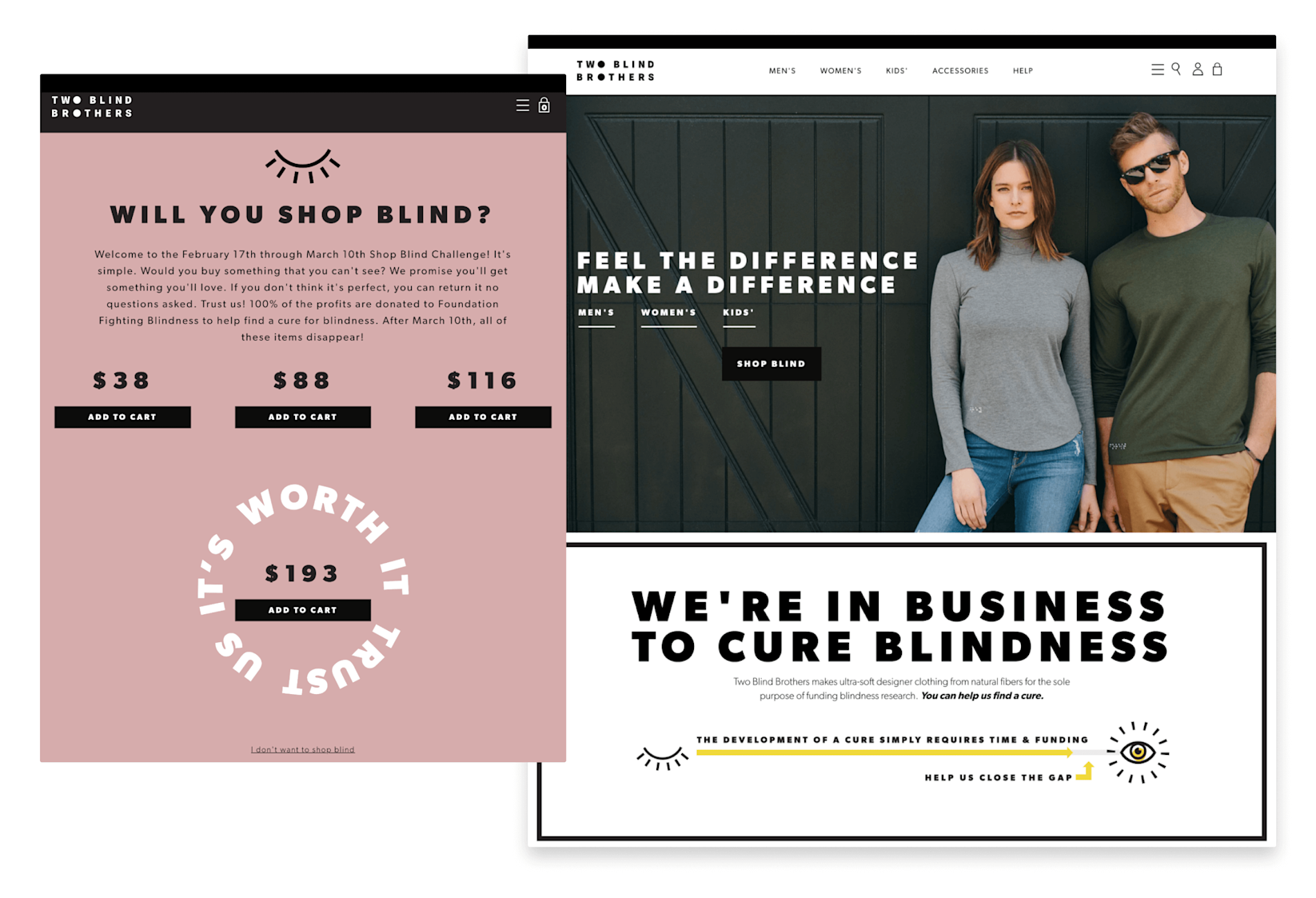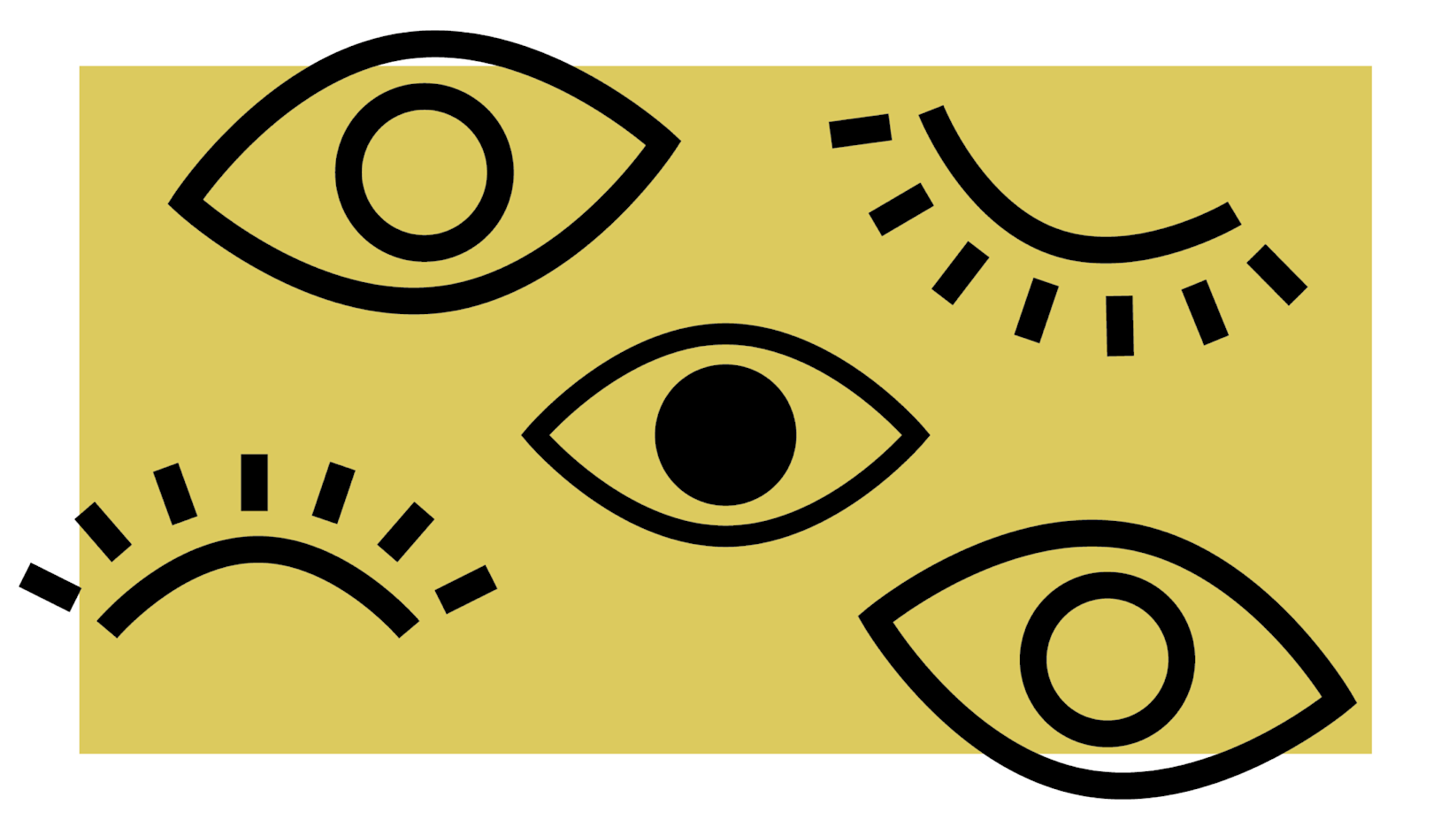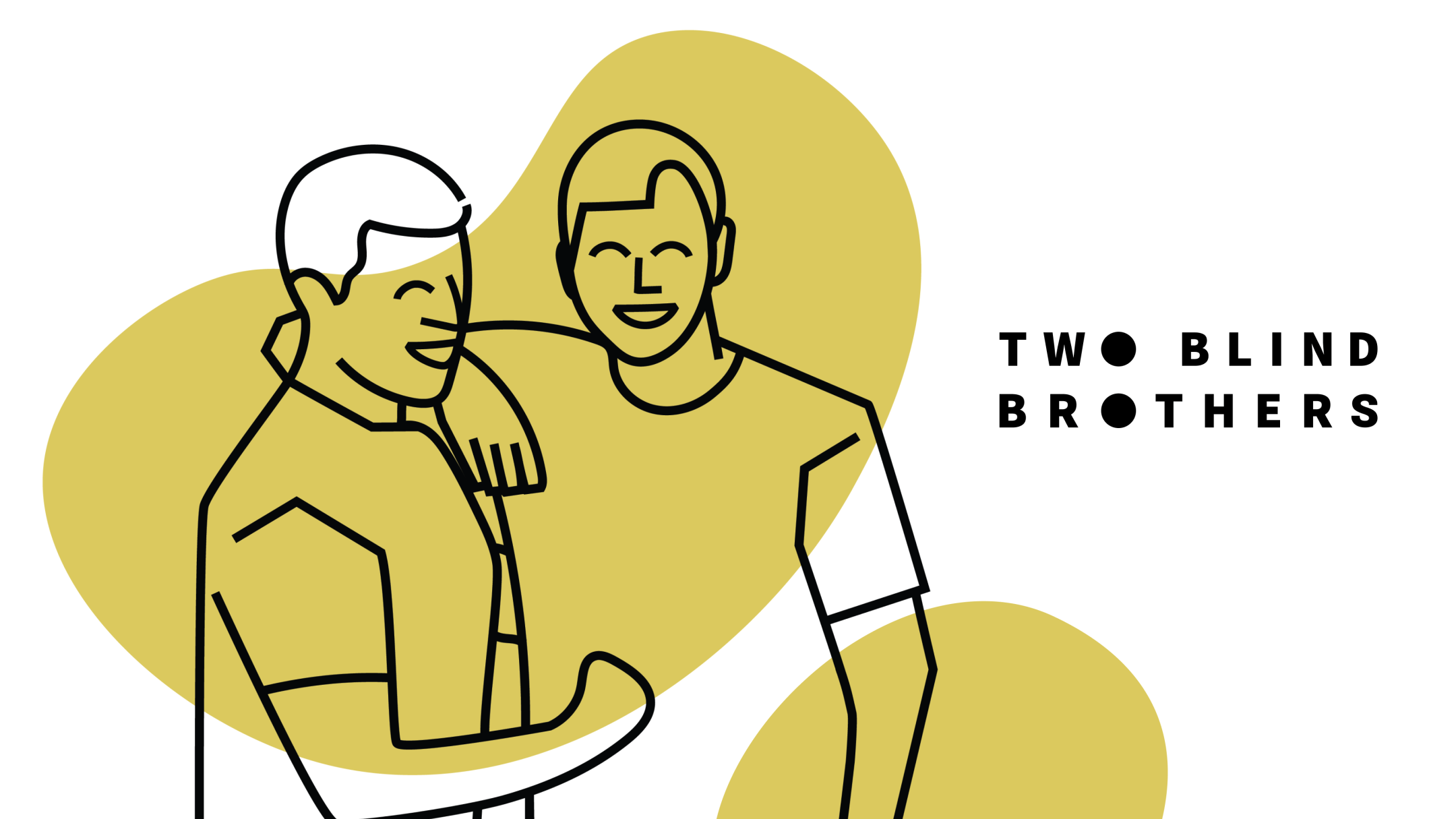Bryan and Bradford Manning act like typical siblings: they make jokes at the others’ expense, reveal embarrassing secrets, and try to one-up each other. Even on a Zoom call, before answering a question, both offer sentiments of encouragement and love before hurling yet another joke. It’s refreshing, and encouraging, to see true sibling affection outside the bounds of perhaps your own—sharing in the secret that all siblings feel a weird combination of competition and affection for the other. And sharing is something of a familiar, common thing with the Manning brothers: Both Bryan and Bradford went to the University of Virginia, five years apart, one with a degree in finance, the other a degree in statistics. Bradford ended up working for a bank before pursuing a master’s degree in psychology, meanwhile, Bryan worked in sales at Oracle.
Bryan and Bradford Manning also have Stargardt disease, which causes loss of sight, something they were diagnosed with when they were children.
This is not the last thing these brothers share.
In 2016, Bryan and Bradford found themselves lost in a New York department store and, coincidentally, bought the exact same shirt without the other knowing. An idea occurred then and there: What if they created a brand that allowed other people without a visual impairment to shop as though they did? And, as that bulb shone brighter in their heads, they thought, what if profits from the brand went to finding a cure?
Nearly five years ago, the Manning brothers abandoned the lives they had crafted up to that point and started a new, wholly unfamiliar journey on the path to fashion and philanthropy. Two Blind Brothers the brand was born.
Two Blind Brothers combines the Mannings’ love for soft, quality clothing and amplifying a cause that's near to their heart. They have become the much-needed representation they sought as children, despite demuring when I make that point. Two Blind Brothers illuminates the barriers in the fashion industry—reconceptualizing inclusivity and diversity for their buyers. In 2017, they launched the Shop Blind initiative where buyers could, in essence, shop like a person with blindness. Shoppers wouldn’t know exactly what they would receive other than a few specifications on clothing type and size.
A crucial brand tenet is trust: learning to trust in the process of buying without sight, touching clothes, and acting, as Bryan says, “a little like a five-year-old.”
The mission-driven origin of Two Blind Brothers
“You have to understand that Bryan and I had no ecommerce experience, no fashion experience, no marketing experience prior to this. We had a desire to do some good,” says Bradford Manning.
The Manning brothers never miss a beat, even if they are in separate states: one in New York, the other in Virginia. Their enthusiasm is contagious. One understands the universal appeal of such joy, promoted on daytime television shows, and in glossy weekly magazines. It feels good to, well, feel good, especially after the last year of staying inside and watching a grim world.
The Manning brothers’ enthusiasm for their business, and life in general, is pure and rooted in a common mission to amplify Stargardt disease, and a broad spectrum of inherited retinal eye diseases, and a possible cure. Almost every question I ask the Manning brothers about their clothing brand brings them back to the curative part of their business goals: They are here to help a wider community and to ensure that blindness doesn’t remain a reason to sit on the margin of society.
First, they tell me, we need to go back to the beginning, to understand how both brothers experienced diagnosis, what Stargardt disease actually is, and how this all informed the foundation of their brand.
Stargardt disease is a juvenile macular degeneration, commonly occurring in people in their 60s or older. The eye has trouble metabolizing vitamin A, which creates a toxic byproduct that impacts the center of the eye. This means that the center of their vision is difficult, as Bryan explains: “Everyone's wearing a mask these days but if you have sunglasses on while you're wearing a mask, it fogs up those sunglasses and it makes it really challenging to see out of that middle point.” Bryan says that their peripheral vision gives them the ability to walk around, keep moving, and navigate through the world. But detailed work like reading small print and recognizing faces is challenging.

According to the Centers for Disease Control and Prevention, 6.8% of children under the age of 18 are diagnosed with an eye condition. Approximately 1 million adults in the United States are legally blind, and vision disability overall is in the top ten of disabilities experienced by adults over the age of 18. These are only a few facts on blindness in the United States, while globally, according to the World Health Organization, it is estimated by 2020, 76 million people will have a visual impairment. As prevalent as these conditions are, the amplification and representation of them still fall very short. Bryan says, at the time, that Bradford was the only other person he knew of with the impairment.
“Brad and I were diagnosed at a very young age—at the age of seven. And at that time, it was kind of fascinating because you don't really have a frame of reference on the world at seven years old, right?”
The brothers attribute their success and outlook on life to their parents, who ensured their kids always knew their worth. They taught Bradford and Bryan that this disease did not have the ability to dictate who they were or would end up being. Not every child receives that kind of compassion, the brothers say, and they realize how lucky they are to have grown up in that supportive environment. Bryan remembers his parents saying his life would be challenging but “that's actually a good thing because you're going to understand one of the largest challenges in your life from an early age. That mentality and that gumption was a really big motivator with this disease throughout our entire lives.”
The Manning brothers have their origin story beats set precisely, presumably from years of having to explain themselves and how they live to people who cannot relate. Not unlike many other differently-abled individuals, able-bodied people have an expectation of Bryan and Bradford to explain their reality. They answer with kindness, but ultimately, Brad and Bryan hope Two Blind Brothers becomes the vessel through which people come to understand the struggles of people living with limited sight.
Back to the store incident, briefly: around the time the brothers lost each other in a Soho neighborhood store, the Luxturna gene therapy had been given to a child to cure a very rare, aggressive inherited retinal disease that causes blindness. The Manning brothers first knew about this medical breakthrough via the Foundation Fighting Blindness and continued to keep up with medical advances.
After they both wandered around this store and purchased the same shirt, Bryan and Bradford felt their a-ha moment with such clarity. What if they could make this medical revolution and the realities of people living with blindness much more tangible to the average person? The goal was to communicate how money flowed to researchers and how progress could be measured. They were going to keep their full-time jobs, work on this project on the side, and donate money where they could to the Foundation Fighting Blindness.
Of course, that’s not exactly what happened.
“When we started this brand, we started with the mission of 100% of the profits going back to researchers,” Bradford says. “These early-stage researchers need funds for a cure for blindness. We thought if we could give a little bit back to these researchers, that would be just such an exceptional moment for us.”
He continues, “We do everything we possibly can and try to donate back 100%of the profits. Since the inception of the business, we've been able to donate over $700,000 to these causes.”
Breaking barriers in the fashion industry and outside of it
Fashion has always had a whiteness, able-bodied problem. So many examples of an ideal life, body, and style have been portrayed by models who are thin and tall with similar features. And while the industry still isn’t perfect, it has at least made attempts to correct itself. Over the past decade, some fashion key brands—Savage Fenty is one key example—have begun embracing the true diversity of the people on this planet: models with canes and in wheelchairs or prosthetic legs; pregnant models; models of varying heights and weights, and many more visible members of our society that have otherwise remained invisible and pushed to the margins. A renewed focus has been put on diversity and representation, but sight continues to be taken for granted.
A recent trend is to correct biases and employ more compassion. Catching ourselves in these spaces of privilege is important. What’s more, acknowledging and amplifying people with limited or different abilities, is an entirely different muscle we need to flex.
In 2016, a French fashion designer employed blind models for their show. These models in couture walked the catwalk with a fish wire as a guide if they needed it. The show served as a way to amplify blindness. Other examples are harder to find. “Blindness is not always something that is heralded,” Bradford says plainly. “There's still a stigma against it [and we learned] through some very hard lessons and great advice from our parents. We were fortunate. We came out the other side stronger. Through challenges, through friction, you grow and inevitably you'll learn resourcefulness, assertiveness, resilience if you can navigate those challenges.”
Both the Manning brothers choose to remain positive about their experiences and the hardships that both endured.
“You know, we can't change the world. But being able to help a mother have her world spin a little bit slower after one of these diagnoses or that daughter being able to have that independence and that joy, that confidence, to go out and play a sport she really loved,” says Bryan, “I mean, if you have to weigh that against anything, that's the most valuable thing we think we can do: empowerment. We can be that inspiration, and be there for people who are just looking to chat with somebody. And that's been such a huge part of this business that we had no idea at the very beginning.”

Trust the process
The Two Blind Brothers website asks its customers one question: Will you shop blind? The text is big and bold with three dollar amounts for a buyer to select from. In some smaller text below, buyers are offered a choice to shop from the collections proper, and not “blind.” Products in these Shop Blind boxes range from socks to sunglasses to shirts and even knit hats. But you wouldn’t know until the day you get to unbox it.
Trust is an interesting concept in commerce. Brand trust and loyalty are crucial for companies to remain successful. Measuring trust is hard but not impossible: if people keep coming back, you’re sure to have a good thing going. It’s different when a buyer is being asked from the outset to trust in a product and a brand without having seen or touched the product. But people living with blindness are asked that every single day and the average person doesn’t even consider that reality.
“Acts of trust actually really empower you. They make life easier. And 99.9% of the time, the person that you're asking appreciates it and the recipient benefits from it,” Bradford tells me. “So, we wanted to create a challenge where we could pay this forward and ask the visitors to Two Blind Brothers to trust us with something they can't see. No products, no images, no descriptions. Just trust in the simple question, will you shop online?”
Translating trust in an online space isn’t all that difficult. Because of the nature of ecommerce, buyers are already being asked to purchase a product they haven’t had any tactile engagement with, relying only on sight. The barrier widens with Two Blind Brothers because sight isn’t even an option with Shop Blind. This cerebral and emotional trust in a brand is a gamechanger. Subscription services, for example, like beauty boxes filled with samples, are a lot like the Shop Blind initiative, except you know the parameters of what you’re getting a bit more than you would here.
But let’s talk about unboxing. A big part of the success of this work, the Manning brothers tell me, is because people love mystery and surprises and uploading a video of it to social media.
“We get tagged in unboxing videos posted all the time on YouTube, TikTok, and Instagram,” Bryan says excitedly. “Just today, a girl posted a video on TikTok and tagged our brand. She bought the Shop Blind box for her blind father. In it, the father opens up the package, and there are a lot of different things that we send and most of it does have some Braille on it. What he got was our socks. On it, it says, ‘Thanks to you, we are one step closer to a cure.’ And, obviously, I'm biased, but they are also a great product. But to watch his reaction, to watch the daughter's reaction, we are so motivated by this.
“There’s no other affirmation of your path quite like thousands of people independently participating in a challenge. That feedback and that ability to understand that quickly can just make you say, oh, my gosh, gosh, this trust idea, the shop line idea is amazing. People are reacting so strongly,” he says.
The thing is, the Manning brothers deliver on quality, too. They are obsessed with product feel, using the softest fabric for their crewnecks, sweatpants, hoodies, and more. They are also exceptionally well-positioned for pandemic life inside, as nearly every brand has pivoted to loungewear.
The excitement their buyers freely give back to the Manning brothers is what keeps them going. So, trust, at least here, is a full circle deal: they trust buyers want to purchase from a value-based brand while giving back to a cause and customers trust the product will be good and a reasonable price, encouraging more people to engage with the brand by posting about it online. Marketing, sales, media promotion, all of it pales in comparison to the moment a person opens that box of products with delight.
To scale or not to scale?
“Sometimes I feel like we're a very bad example for prospective entrepreneurs because truthfully, this started with a passion without regard for what the business success would be,” Bradford says jokingly. I hesitate to follow-up with a question more specifically geared toward advice because it’s true that Two Blind Brothers was sort of accidental. What started as a way to give back to their community, to ensure broader visibility of the struggles of children and adults with blindness, became something much bigger than either had anticipated. This, they suppose, is the sort of scale that occurred. Where the business goes after this is a little unclear.
Bradford says the team adapts its business plan every few months. “We've always committed to the idea that this has to be community first. It has to be 100% charitable in nature. And we have to have a ton of fun doing it.”
He continues: “Luckily, we've grown enough where we have some great ability. We have a customer base, our short-term goals will change over time. We have operational goals we want to solve for, you know, we have marketing goals that we are working on so that we get greater distribution on our messaging.” The COVID-19 pandemic impacted Two Blind Brothers, like nearly every other corner of commerce and real-life over the past year, but only that has been their significant challenge. They are content to remain at the pace and place where they are currently. Scaling might alter the philanthropic direction of the brand, and that’s something neither brother is willing to compromise on.
“The last thing that we want to do is put us in a position where we have to drift from our mission, drift from the community, or get us into a situation where we can't have fun and enjoy, you know, the process around this,” Bradford says.






